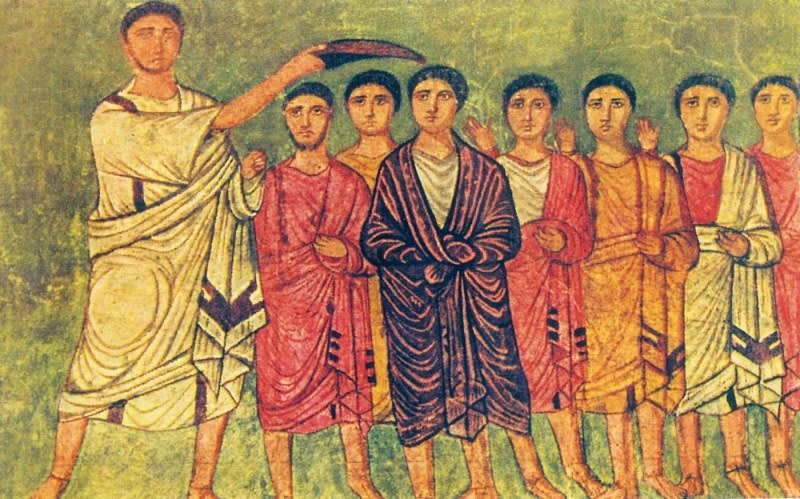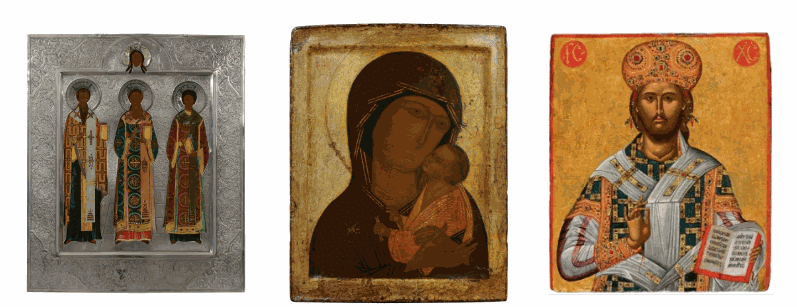Recent trips were successfully completed in Ravenna and to Saint Catherine’s, Sinai.In Ravenna (and also in Rome last year) we were much intrigued by patterns on the robes of saints in 6th century mosaics, often in the form of an L (gamma).After some searching, I have found that the meaning of the gammadion on the clothing of the Ravenna mosaics is regarded by historians as ‘ambiguous’, In other words, nobody really knows. Like most ancient symbols, it can be found in many cultures across East Asia, the Orient and the West. Many different interpretations can be found - for example, that its represents the 'Sun'. The eastern version of the gamma symbol was notoriously appropriated by the National Socialist Party in 20th century Germany as the 'swastika'. Similar patterns can also be found on the garments in the Synagogue frescoes at Dura-Europos (see image below).

|
It seems that Christianity appropriated this symbol for its own purposes, with Christological significations. It is first found in this context in the fourth century Roman catacombs (as we saw last November). In Ravenna it is found on the garments of saints and on the veil of the altar. These references also correlate to the actual priestly vestments and liturgical textiles from this period (see images below).
|
|
|

The Temple Gallery, with twenty-one people, visits the Imperial God-Trodden Holy Mountain of Sinai
There is much to confuse the western visitor prior to visiting Saint Catherine’s. The trip begins with a day in Cairo, with the chaos of its street life, its fabulous Mamluk mosques, the Coptic Museum’s astonishing seventh century images, and the Pyramids: an objective statement of consciousness and wisdom, rising imperviously above the feverish mass of tourists, hucksters and armed police below them.
An evening flight to Sharm El Sheikh, now, incongruously, a Florida-style luxury resort at the southern point of the Sinai peninsula, and then a dawn departure into the desert. Accompanied by two armed guards, and passing through five police checkpoints, we penetrate deeper into the rocky mountainous terrain, climbing to five thousand feet, finally arriving at Saint Catherine’s, famously founded by the emperor Justinian in the sixth century on the site where the Holy Prophet Moses received the tablets of the Law from God, and the oldest continuously functioning Byzantine monastery in Christendom. Hallucinatory clear light. Howling wind. 6° Celsius.
For fifteen-hundred years its remoteness and inaccessibility protected it from periodic waves of destruction: the Muslim Caliphate in the seventh century, the Iconoclasts in the eighth, the Crusaders in the eleventh, Napoleon, the British during WWI, the Arab-Israeli Conflict of 1967. Saint Catherine’s survived them all. Now the threat of tourism presents the greatest danger.
We see the sixth century icons in the Treasury, an impression no book or computer screen can prepare you for. Saint Peter, Christ, the Mother of God speaking to us personally, directly.

|
The place is run by the local Bedouin, an arrangement made with the monks by the Prophet Muhammed when he visited in 610 and which still holds good today. Everything is done in the Arab way, by negotiation: ‘no’, ‘maybe’, ‘later’, ‘soon’. We see the Burning Bush that was not consumed by fire that Moses saw, and eventually the inimitable Father Justin meets us and we tour the icons in the katholicon, and see huge the 6thcentury Constantinopolitan mosaic of the Transfiguration. We were told we could not attend the Vespers, but somehow we did, and were blessed by its depth and ancient resonance.
The next day Father Justin shows us the Library and some of its thousand-year-old illuminated manuscripts. He tells us about monastic life.
|
|
|
At one point he takes a call on his cell phone. We hear him say ‘he’s rather late but send him right up.’ Then, looking at us with a twinkle in his eye, ‘he’s a New Testament professor from Wisconsin.’
That twinkle is always there, along with humility, service to others and prayer.
Later, some of us make the famous climb to the top of the mountain. It’s pretty arduous. At the summit the wind, which is much less strong today, drops completely. Absolute stillness, the Great Silence.
Back home, it’s hard to believe were in that exalted place, but the thought awakens a memory, an inner exaltation, never to be forgotten.
A Recommended Read
Janet Martin Soskice. The Sisters of Sinai: How Two Lady Adventurers Discovered the Hidden Gospels. (Alfred Knopf, New York: 2009) is a fascinating account of two highly educated Scottish Victorian ladies who travelled to Saint Catherine’s and discovered extraordinarily important manuscripts, somewhat to the annoyance of the academic establishment.
Sinai Icons
The vast collection of icons at Saint Catherine’s, most of which are not on view, is published at https://www.sinaiarchive.org/s/mpa/page/sinaicollection.
November Trip to see Early Netherlandish School Paintings 6 – 11 November. (For detailssee previous Newsletters)
Our trip to Bruges and medieval Flemish cities in November to look at Van Eyck, Rogier van Weyden, the Master of Flemalle, Pieter Bruegel the Elder and other Netherlandish painters is now well subscribed. If you are especially interested, it is still possible to find you a place. Please contact Greg Godar at Greg greg.godar@etrtours.com
Proposing a trip to the ancient Kingdom of Georgia. May 2024. 7th-18th May 2024In May 2024,we shall make a trip to Georgia. The main study will be art and architecture but Georgia offers astonishing cultural riches: music, medieval churches and frescoes, spectacular landscapes, and rich traditions of food and hospitality. And wine.The proposed dates are 7th-18th May 2024. Further details to come. For a place on this trip please contact Greg Godar at ETR. greg.godar@etrtours.com
|
Tom Bree, The Cosmos in Stone, Sacred Geometry of a Master Mason The Squeeze
Press. ISBN-13:- 978-1-906069-21-6. 422 richly illustrated pages. £25
Tom is a former student of the late Keith Critchlow and teaches sacred geometry as a practical art at the Prince's Foundation School of Traditional Arts, London. He has a good YouTube presentation here.
I hope to write an appreciation of this important publication in our next Newsletter.
With good wishes from us all at the Temple Gallery,
Dick Temple
May 2023
|
|
|
9 May 2023












